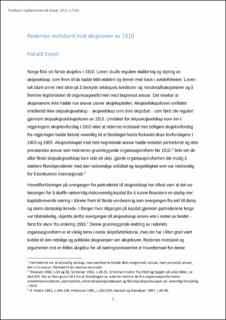| dc.description.abstract | Norway got its first limited liability company law in 1910. The law was to regulate the establishment and management of limited liability companies, which until then had been established and operated based on freedom of contract. The law’s objective was mainly to protect the company’s creditors and minority shareholders, and to promote the legitimacy of the organizational form with limited liability. This meant that the shareholders had no liability beyond the share capital. However, the Companies Act did not cover shipping companies – limited companies that operated shipping – which was first regulated by the Shipping Companies Act of 1916. The exemption for shipping companies came into the Government’s Companies Bill in 1910, after shipowners’ opposition to previous government bills from the government had contributed significantly to the Storting discarding the bills in 1903 and 1905. The limited company had replaced the partner shipping company and its pro rata liability, as the shipping companies’ basic form of organization before 1910. This fundamental change in the shipping company’s organizational form is an important theme in Norwegian shipping history, but it has to a small extent been linked to the legal and political tug-of-war over the Companies Act. Shipowners’ opposition and arguments against a common company law for all business activities are the main topic of this article. The shipowners are here understood as the shipping companies’ general managers, who were often referred to as manager or managing shipowners in a shipping company or partner shipping company. The manager or managing shipowner often had a significant shareholding in the shipping company(s) they managed. The article sheds new light on the shipowners’ views on corporate governance in limited companies. It differed markedly from other parts of the business community that used this organizational form, and where the Companies Act’s mechanisms for protecting minority shareholders and creditors were not controversial. Four questions are central in the article. Which provisions in the draft of Companies Act did the shipowners oppose? Why did the shipowners react so late if the bill was as important as they claimed? To what extent was the government willing to comply with the shipowners’ demands within the framework of a Companies Act? And, why did Norway get its own Ship Companies Act despite the shipowners being relatively satisfied with the changes proposed in the Companies Bill of 1904-1905? | en_US |
